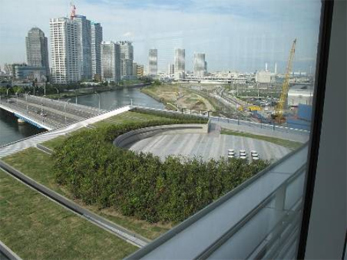Archive
Archive
This is where you can view Nissan's efforts in previous environmental action plans and other important past activities.
Please find our previous sustainability reports from here.
NISSAN GREEN PROGRAM 2022
Climate change (Product)
Long-term vision: Realize carbon neutrality by 2050
| Activities | NGP2022 Objectives |
|---|---|
|
40% reduction of CO2 emissions from new cars (vs. FY2000; Japan, U.S., Europe and China) |
|
- |
|
Pilot program with connected cars |
|
Global expansion of V2X for energy management (Japan, U.S. and Europe) |
Climate change (Corporate)
Long-term vision: Realize carbon neutrality by 2050
| Activities | NGP2022 Objectives |
|---|---|
|
30% reduction of CO2 emissions per vehicles sold (vs. FY2005, global) |
|
36% reduction of CO2 emissions per vehicles produced (vs. FY2005, global) |
|
12% reduction of CO2 emissions per production (vs. FY2005; Japan, North America, Europe and China) |
|
12% reduction of CO2 emissions per floor areas (vs. FY2010) |
|
12% reduction of CO2 emissions per floor areas (vs. FY2010; Japan) |
|
Expansion of renewable energy introduction |
Air quality
| Activities | NGP2022 Objectives |
|---|---|
|
Promotion of research on technical solutions |
|
Promotion of VOC emission reduction per paint areas vs. FY2010 |
Resource dependency
Long-term: Reduce dependency on new materials by 70%
| Activities | NGP2022 Objectives |
|---|---|
|
Promotion of research on technical solution |
|
Implementation of the Alliance policy on chemical substance management |
|
More than 30% (in weight) of a new vehicle to be non-new material resources |
|
Duplation of remanufactured item coverage (vs. FY2016) |
|
Expansion of the EV battery reuse business |
|
Plan and implement technical development |
|
BAU 2% (Japan) and BAU 1% (overseas) reduction of waste |
|
Landfill ratio reduction |
Water scarcity
| Activities | NGP2022 Objectives |
|---|---|
|
21% reduction of water withdrawal per global production (vs. FY2010) |
Business foundation
| Activities | NGP2022 Objectives |
|---|---|
|
Implementation of our environmental compliance policy |
|
Measure life-cycle environmental impact of vehicle and new technology |
|
Implementation of environment data survey to promote engagement and reduce environmental impact |
|
Further promotion of Supplier THANKS activities |
|
Adoption of updated policy |
|
Global expansion of Nissan Waku-Waku Eco school program |
|
Enhancement of collaboration and partnerships with NGOs |
NISSAN GREEN PROGRAM 2016
Under NGP2016, the company continued taking steps toward its ultimate goal of reducing environmental dependence and impact to levels that nature can absorb. The targets set for four key initiatives under the program, Zero-emission vehicle penetration, Fuel-efficient vehicle expansion, Corporate carbon footprint minimization, and Natural resource use minimization were fully achieved.
| Key Focus Area | NGP2016 Target | NGP2016 Results |
|---|---|---|
| Zero-emission vehicle penetration | Achieve number-one global market share | Achieved number-one cumulative sales and market share |
| Fuel-efficient vehicle expansion | Improve CAFE by 35% from FY2005 | Improved by 36.5% (achieved in FY2014) |
| Corporate carbon footprint minimization |
Reduce CO2 emissions of global corporate activities by 20% (t-CO2 /vehicle, vs. FY2005) |
Reduced by 22.3% (achieved in FY2014) |
| Natural resource use minimization | Increase recycled material usage ratio per new vehicle by 25% | Achieved rate of over 25% |
NISSAN GREEN PROGRAM 2010
We have completed most of the action plans intended to target three key issues-reducing CO2 emissions, reducing other emissions (to protect the air, water and soil) and recycling resources-for NGP2010, which was launched in 2006. During this time, we introduced many new environmental technologies to the market as we focused on reducing CO2 emissions in all of our business fields. We also established an environmental management framework and steadily moved forward with measures for achieving our long-term goals.

Brochure "NISSAN GREEN PROGRAM"
NISSAN GREEN PROGRAM 2010 (English)

Nissan's Environmental brochure has been updated and issued in Feb 2009. This handy brochure concisely introduces Nissan's targets in NGP2010 and current activities/results on environment, focusing on our products and technologies in global scope. The brochure is now available in Japanese and English.
NISSAN GREEN PROGRAM 2005 Performance Report

Nissan has released the Nissan Green Program 2005 Report, which covers efforts made under the Nissan Green Program 2005, our five-year environmental action plan.
Important past activities
The History of Nissan's Fuel Cell Electric Vehicle Development
Earnest development of FCEVs is still in its infancy; even on a worldwide basis, the technology is less than two decades old. Nissan's initial foray into the full-scale development of FCEV technology came in 2001 with an investment in a five-year, ¥85 billion joint development project with our Alliance partner Renault.
September 2012
The Nissan TeRRA SUV concept was unveiled at the 2012 Paris Motor Show
Click here for more information
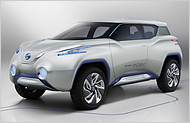
The Nissan TeRRA SUV concept
August 2008
Nissan announces the development of a next-generation fuel-cell stack with double the power density of conventional technology.
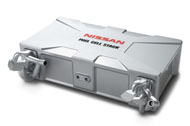
Nissan's next-generation fuel-cell stack
February 2006
Road testing begins in Canada.
Test runs are initiated on an X-Trail FCEV equipped with a 70 MPa high-pressure hydrogen storage cylinder.
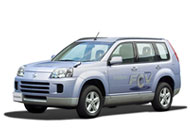
2005 X-Trail FCEV equipped with a 70 MPa high-pressure hydrogen storage cylinder
December 2005
Nissan unveils the 2005 X-Trail FCEV
equipped with the company's newly developed fuel-cell stack.
Nissan develops an X-Trail FCEV with a 70 MPa high-pressure hydrogen storage cylinder.
December 2003
A limited number of X-Trail FCEV 03s are made available for lease.
FCEV 03s are delivered to Cosmo Oil Co., Ltd., in March 2004, and to the Kanagawa prefectural government and the Yokohama city
government in April 2004.
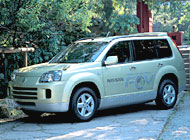
2003 X-Trail FCEV
High-pressure hydrogen-powered
December 2002
Nissan begins road testing the Xterra FCEV in Japan. Road testing of the high-pressure hydrogen-powered X-Trail FCEV begins in Japan after approval is received from the Minister of Land, Infrastructure, and Transport.
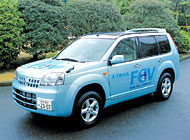
2002 X-Trail FCEV
XHigh-pressure hydrogen-powered
April 2001
Public road testing begins in North America.Nissan begins a five-year, ¥85 billion joint development project with Renault.Road tests are conducted on the Xterra FCEV in Sacramento, California.
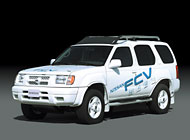
Xterra FCEV
High-pressure hydrogen-powered
March 2000
Nissan participates in the California Fuel-Cell Partnership (CaFCP).
May 1999
Vehicle testing begins.
Nissan test drives the R'nessa, an FCEV equipped with a methanol reforming fuel cell.
1996
Nissan begins developing FCEV technology.
Toward Increased Biofuel Use
Nissan's approach to biofuels
Biofuels are produced mainly from plant matter, such as sugar cane, corn and construction waste material. These fuels are a renewable energy source. Since they are produced from plants that have absorbed CO2 during their lives, they do not add significantly to overall CO2 levels and have been a focus of considerable attention as a renewable energy source. In North America, Nissan markets flexible-fuel vehicles (FFVs), cars whose gasoline engines can handle ethanol-based fuel mixtures without problem. The Titan King Cab FFV and Armada FFV can run on E85, fuel containing 85% bio-ethanol. In March 2009, we began marketing our flex-fuel Livina, the first Nissan vehicle that can run on any bioethanol blend (E100), in Brazil.
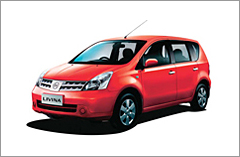
Flex-fuel Livina
Vehicle trials aiming to boost biofuel use
In April 2008 Nissan began taking part in the Tokachi E10 trials. Held in Hokkaido's Tokachi region, this project, the first of its kind in Japan, seeks to increase the use of E10 fuel. The Tokachi E10 project is one of many funded by Japan's Ministry of the Environment with the aim of addressing climate-change issues through technological development. The Tokachi Foundation, commissioned by the ministry to manage this project, is working toward the broad adoption of E10 fuel. By getting vehicles on the road running on E10, the project aims to promote development of the technologies needed for the cars and distribution of fuel for them. As part of its participation in the project, Nissan provided the first automobile in Japan to receive authorization as an E10 vehicle from the Ministry of Land, Infrastructure, Transport and Tourism.
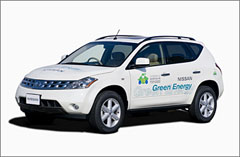
The Murano E10 used in the Tokachi project
Nissan pioneers fuel-cell limo
In February 2007, we delivered the latest X-Trail FCEV to Kanagawa Toshi Kotsu Ltd. for use in their chauffer-driven hired-car fleet. This was the first time fuel cell electric vehicles were made available for hired-car services anywhere in the world.
Click here for more information on fuel-cell limos
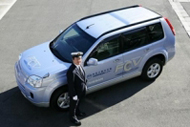
X-Trail FCEV used as a hired car
Recognized "S" ranking under CASBEE
Using the ISO 14001 management processes for evaluating environmental impact, Nissan seeks to optimize its building specifications in the construction and refurbishing stages. Our evaluation metrics in this area include buildings with a smaller environmental footprint, such as lower CO2 emissions; construction methods that produce less waste and emissions; and reduced use of hazardous materials and other quality control tasks. Ongoing improvements are made through the PDCA cycle. In Japan we also use a performance index, Comprehensive Assessment System for Built Environment Efficiency (CASBEE), defined by the Ministry of Land, Infrastructure, Transport and Tourism. Among Nissan's current business facilities, the Nissan Advanced Technology Center (NATC) in Atsugi, Kanagawa Prefecture, and our Global Headquarters in the city of Yokohama have earned CASBEE's highest "S" ranking. The Global Headquarters, in particular, scored a Built Environment Efficiency rating of 5.6, which is a high score of CASBEE rating for a new construction, earning it the distinction as one of the most environment-friendly and efficient buildings in Japan. In addition to its thoroughgoing environment-friendly design, it was recognized for its efficient use of natural energy sources, CO2 emissions reductions, recycling of water and drastic waste reductions.
- CASBEE:Comprehensive Assessment System for Built Environmental Efficiency
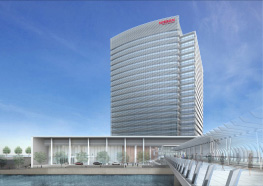
Global Headquarters in Yokohama, Kanagawa Prefecture.
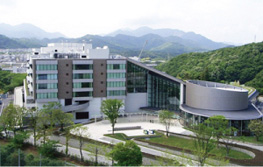
Nissan Advanced Technical Development Center, in Atsugi, Kanagawa Prefecture.
Environmental Features of Our Global Headquarters
Utilization of natural light
Natural light is maximized with a curtain-wall exterior and active use of sunlight in the central channel of the building, which is collected by five sets of condensing lenses that track the sun automatically. One of the distinctive features of the exterior is the use of window louvers, which control the amount of sunlight, contributing not only to natural lighting but also to air-conditioning energy savings.
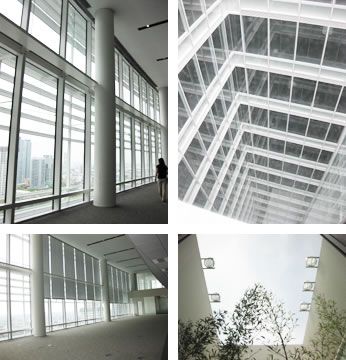
Utilization of fresh air and an efficient air-conditioning system
Super-insulated glass and the louvers regulate interior temperatures. Air-conditioning energy consumption is controlled by dampers installed in the exterior wall, which automatically detect wind speed and humidity and allow fresh air to flow into the building. An additional energy-saving feature is the use of ascending air current generated by the building's central channel, which reduces energy required for ventilation.
BEMS (Building Energy Management System)
The building features BEMS, a management and control system that automates and unifies the building's overall energy conservation monitoring and control.
Reuse of resources and greening
Rainwater and miscellaneous drainage, including that from the kitchen, are processed and used as sanitation water and for plant watering. With the green roof system on the gallery, 11% of the total lot area is devoted to green space.
